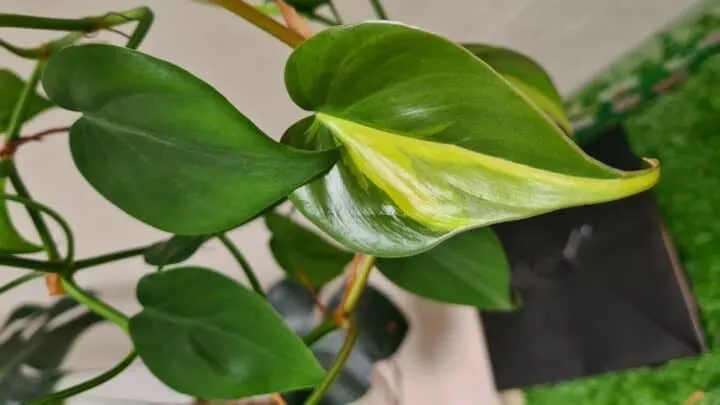Philodendron Brasil, also known as Philodendron hederacerum var. oxycardium ‘Brasil’, is a climbing Philodendron native throughout much of South America.
It is a hardy and brightly colored houseplant. Each of its variegated leaves is unique and will look different than the rest.
Read more about how I care for this beautiful Philodendron.
Philodendron Brasil Care
Philodendron Brasil prefers a well-draining, slightly acidic soil while giving it water when the top inch of soil dries out. Provide bright indirect sunlight. Use a soil mix containing potting soil, peat moss, perlite, and orchid bark. The temperature should be between 60 to 85 degrees Fahrenheit (16 to 29 degrees Celsius) should be maintained. Fertilize monthly during summer and spring and once every 6-8 weeks during the winter and fall.
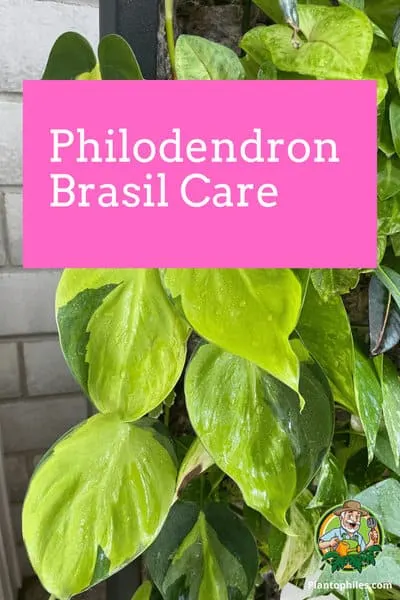
Philodendron brasil Care
Table of Contents
Philodendron Brasil Indoor Care Guide
Soil
A potting mix that drains well such as an Aroid mix containing orchid bark and perlite is ideal for Philodendron Brasil.
Potting mixes are truly limitless, and any combination will suit as long as proper drainage is provided.
I prefer to include perlite or even orchid bark pieces to a nice all-purpose soil mix, or whatever you have on hand, to make the mix very well-draining for my leafy Philodendron Brasil.
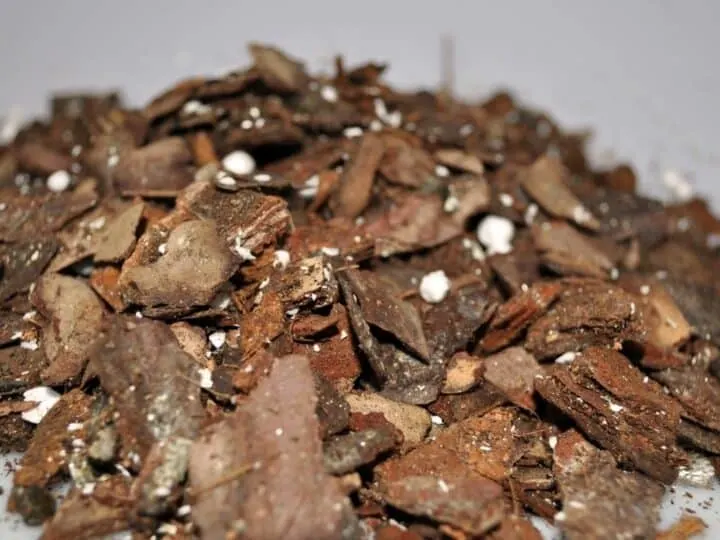
Using Orchid Bark Pieces for Philodendron Brasil Soil Mix
Three parts of all-purpose potting mix plus one part of perlite work well for this plant. Other soil mixes that can be used are:
- ½ orchid plus ½ potting mix
- ½ peat moss plus ½ potting soil
- ¼ pumice plus ¾ potting soil
Water
When it comes to watering Philodendron Brasil, I prefer to follow my basic procedure for almost all of my indoor plants.
To have a better idea of your plant’s watering needs, use your finger to evaluate the dampness of the soil. Extreme moisture is a big no for this plant.
Never let your Philodendron Brasil dry out entirely. If you continue doing this, your bottom leaves will become brown and yellow, and the plant will become leggy.
On the other hand, make sure there are plenty of drainage holes and don’t allow this plant to sit in the water for very long, or it’ll rot.
Allowing the top inch of soil to dry out prior to watering again would be a general rule of thumb. As long as you minimize extremes in soil moisture, these plants can withstand a lot of neglect.
Any extra water should be discarded, as wet soil might induce root rot. Make sure your plant’s pot has at least one drainage hole, regardless of the sort of container it’s in.
Light
Even though many Philodendron types are labeled as low-light plants, the variegated Philodendron Brasil will require more light.
They can handle a wide range of lights, but they will perform best if you provide them with bright indirect light, which you may augment with artificial light if your house lacks adequate windows.
The multicolored variety of a plant, in many circumstances, requires more light than the non-variegated species.
If you don’t you’ll lose some of the variegations, which is likely what led you to decide to get this plant in the first place.
Philodendrons prefer strong indirect light overall. A little bit of direct sunlight will undoubtedly improve the appearance of your plant.
Just don’t let your Philodendron Brasil out in the sun for the entire day. They aren’t supposed to be exposed to a lot of direct sunlight.
A bright North window and an East window that gets some early sun would be ideal.
It enjoys it when I put it in a warm area in front of an Eastern-facing window. Even the most recent leaf is entirely multicolored.
Don’t expose your Philodendron Brasil to excessive direct sunlight. If you only have highly sunny Western or Southern windows, you could wish to move your plant to the side or far off from the window.
Another way to filter the sun for highly sunny rooms is to use thin curtains or shades. Eastern windows may or may not be suitable for you, depending on the place you’re residing.
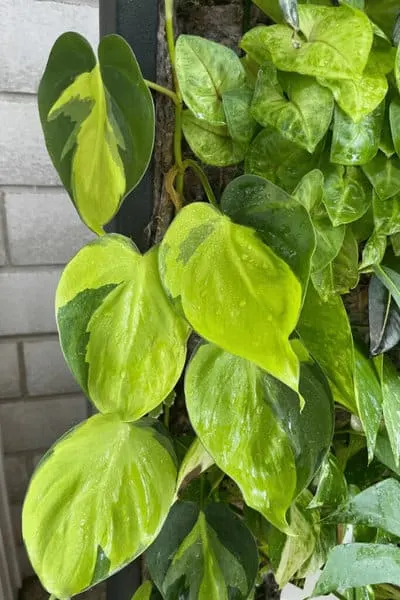
Philodendron hederacerum var. oxycardium ‘Brasil’ is a vining plant
Temperature
In general, if you are satisfied with your houseplants, they will be as well! Normal room temperatures will be sufficient.
Philodendron Brasil prefers warmer temperatures, and a temperature range of 60 to 85 degrees Fahrenheit is optimum (about 16 to 29 degrees Celsius).
Temperatures below 55 degrees Fahrenheit must be prevented at night (approximately 13 degrees Celsius).
For most houseplants, this is a reasonable general rule. Finally, stay away from any cold draughts.
Humidity
Philodendron Brasil being a tropical plant loves humidity, but it can withstand the moderate humidity that exists indoors.
A humidity level of 40% will be ideal for your plant.
Fertilizer
Use a balanced liquid leaf houseplant fertilizer containing macro-nutrients to nourish Philodendron Brasil.
Fertilize the plant once monthly during summer and spring and once every 6-8 weeks during the winter and fall seasons.
The Philodendron Brasil sluggish development and tiny leaf size are signs that it isn’t receiving sufficient fertilizer.
Dull new growth is usually an indication that Philodendron Brasil is lacking in calcium and magnesium, both of which are important micronutrients for philodendrons.
Repotting
When you find that the Philodendron Brasil requires more watering than before, repot it.
Aside from that, you can replant every two years in the same pot with a diameter somewhat bigger than the previous pot.
- Begin with a standard potting mix of a decent grade. Use sterile, pest-free potting soil that is lighter in mass than topsoil. Many come with a moderate starting fertilizer included in the mix.
- Choose a container with drain holes.
- If there aren’t any, remember to create drainage holes.
- Fill the pot up to 2 inches (5 cm) of soil from the planter’s rim.
- Take the Philodendron Brasil out of the pot.
- Make a tiny opening in the soil somewhat larger than the root ball by hand or with a shovel.
- Place the plant in the opening and pack the soil all around the roots tightly.
- Water your Philodendron Brasil generously once it has been planted to compact the soil and give the plants a healthy start.
- Place your Philodendron in a sunny area.
Pruning
Philodendron Brasil grows quickly in the correct circumstances and may need pruning to keep its growth reasonable indoors.
Pruning encourages thicker growth and broader foliage as well. When your Philodendron Brasil is growing strongly, trimming must be performed in the spring or early summer.
Trim any unusually long or untidy branches that have begun to sprout little leaves with a pair of sterile, sharp scissors or pruning shears. Set away the stem cuttings; these can be used for propagation.
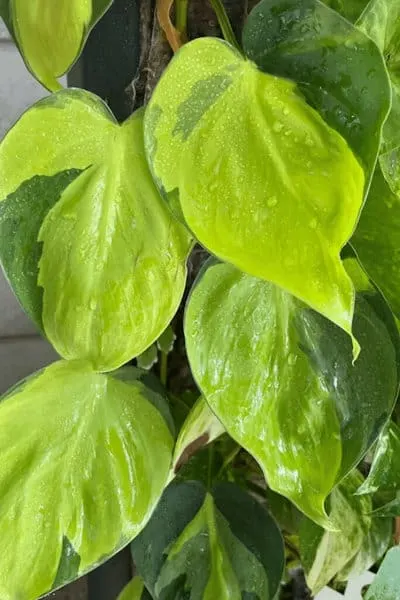
Green and yellow variegated leaves
Propagation
Philodendron Brasil can be propagated by taking stem cuttings containing at least one node. Ideally, take a cutting with 3 nodes and 2-3 leaves for the best results.
Propagating this plant is pretty simple. Basically, take cuttings from your vines and submerge them in water or straight into the soil.
The nodes are where the leaves of the plant connect to its stem. This is where new shoots and roots will emerge.
Leave the cuttings in the water for at least one or more nodes. You should also check to see if your cuttings still have one or two leaflets on them.
The optimal time to propagate is during the primary growing season when you will get faster and the best results. The months of spring and summer are great.
Because the nodes always have roots, they will grow quickly in water. You can transplant them to the ground until they reach the length of 1 inch.
Soil Propagation
You can also soak the Philodendron Brasil cuttings in rooting hormone and put them immediately in the soil to speed things up. However, the rooting hormone is not required.
Just bury the node by placing numerous cuttings in a pot. Pre-moisten the soil (2-3 parts potting soil to 1 part perlite), then place the cuttings and wet the soil once more.
It’s really as simple as that! To stimulate rooting, maintain the soil moist, and each of the node cuttings will develop a plant.
You’ll need about 6-8 cuttings for a 4-inch container. Don’t just plant one or two since you won’t get a whole plant that way.
You can also obtain a lot more branches if you are using one node cut.
Blooms
The blooming time for Philodendron Brasil is during spring and summer.
It produces flowers that are white and green in color.
Growth
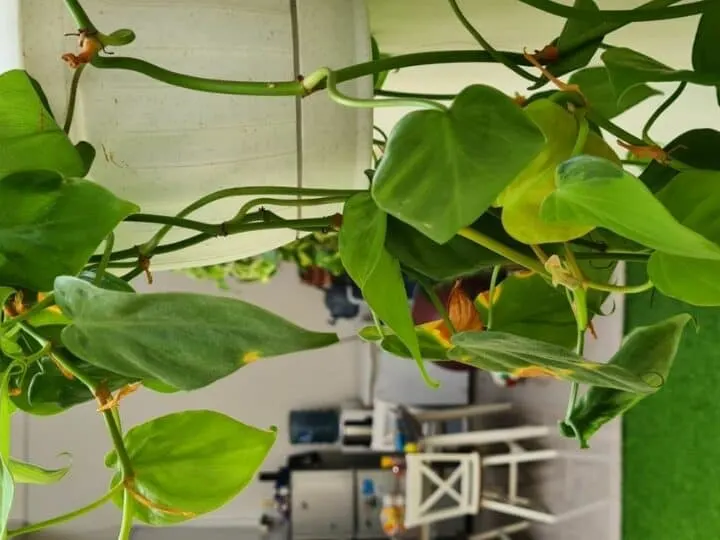
The Philodendron Brasil is a plant that you can hang or place on a table. It can be trained to climb a trellis, a moss rod, a bamboo hoop, or a piece of bark, among other things.
If you’re seeking a plant that proliferates, Philodendron Brasil’s got you on this. It’s grown over 2 feet during the 1 1/2 year that I took care of it.
Its dark green leaves are shaped like a heart and have stripes of lime green throughout.
Philodendron Brasil can grow to a height of around 0.5-3 feet (0.15-0.9 meters) and to a width of 1-3 feet (0.3-0.9 meters).
You will find Philodendron Brasil in 4 to 8 inches grow pots, and they can trail up to 5-7 inches.
Philodendron Brasil Problems
Philodendron Brasil Reverting to Full Green with Less Variegation
Philodendron Brasil is variegated but may turn more green to completely green if it does not get sufficient light. Move the plant to a new spot with bright indirect light to increase variegation in case it reverted
it needs more light than its green heartleaf sibling, so consider relocating it; else, it may return to all green.
If your pal has already thrown out a totally green leaf, consider clipping it off at the point where the previous leaf was still variegated.
You can also look at the stem to see whether there is a visible variegation stripe. We’ve tried propagating totally green leaves before and found that the resulting plant is usually reverted.
Yellow Leaves on Philodendron hederacerum
Typically, yellow leaves are only a sign that an old leaf is nearing the end of its existence. If the yellowing is mainly on one side of the plant, it may need to relocate, as concentrated yellowing on one side or on fresher foliage is generally a symptom of too much light.
Yellowing leaves can be a symptom of a more serious condition if they aren’t an old leaf or one section on the side where it receives the most light.
Over-watering is the most prevalent reason in this situation. If the soil is excessively wet, don’t water it until it’s completely scorched.
If it’s looking very bad, use paper towels on the topsoil and under the container to remove the excess.
Dry Leaves
Usually, this is caused by shriveled and dehydrated older leaves. Every spring, we embark on a thorough search around Philodendron Brasil for old leaves to discard.
It’s a good idea to clean up to create a way for all of the beautiful new spring vegetation.
Small Leaves
The typical suspects could be to blame, but in our opinion, it’s most often due to vining downwards rather than ascending up, a shortage of humidity, or it needs nourishment.
Give your Brasil anything to crawl on that has fibers to cling to if everything else is great, but the leaves aren’t quite big enough.
In my opinion, stability plus going up, rather than dangling, results in considerably larger leaves.
Higher humidity also aids in the production of larger leaves. Another cause could be a deficiency of something, but you’ll usually notice other indicators of health problems if this is the case.
Rootbound
Philodendron roots can develop quickly, so lift them out to inspect them if your Philodendron Brasil roots are spreading out of the container.
Transplant it one size larger if it’s root-bound.
If you want Philodendron Brasil to expand out far more, go up two sizes approximately 5cm in diameter to stimulate it to do so.
Tips for Growing Philodendron Brasil
- Don’t be hesitant to prune your plant back if it’s become a little dry and spindly. This will stimulate new development.
- When you discover any brittle or decaying foliage, discard them immediately. A thriving plant is one that is fresh.
- Always keep your pruning tools disinfected to avoid problems for your plant.
Philodendron Brasil benefits
The Philodendron Brasil purifies the air. It filters toxins such as benzene and trichloroethylene from the air. According to the NASA study, Philodendron Brasil removed 8480 micrograms of formaldehyde per plant in a 24 hours exposure period.
Several Philodendrons such as the heart-leaf philodendron are known as air purifiers according to the University of Florida and confirmed by the NASA study in September 1989.
Philodendron Brasil Climbing
Philodendron Brasil is a climbing plant. You can let it either climb up a moss pole, wall or trellis or let it trail. It is a great climber and the leaf and stems size will increase the higher it climbs. In nature it climbs any surface it can find and it will reach a length of up to 20 feet (6 meters).
Philodendron Brasil flower
This plant produces white and green flowers between May – July. It might take more than 15 years for it mature enough to produce an inflorescence. They rarely flower indoors and are mainly cultivated for their showy variegated leaves.
Philodendron Brasil pink
Pink leaves on a Philodendron hederacerum var. oxycardium ‘Brasil’ are normal. When new leaves emerge from this plant they start out with a slightly pink hue and then turn into a unique green, yellow leaf. The pinky-peach color will disappear once the leaf hardens off.
If older leaves turn pink, other reasons such as too much sunlight, too much fertilizer or underwatering might be the culprit.
Philodendron Brasil vs. Pothos
Philodendrons as well as Pothos belong to the Araceae family and are considered to be Aroids. However, they belong to a different genus. Pothos belong to the Epipremnum genus and Philodendron Brasil belongs to the Philodendron genus.
Similarities are that both plants are vining plants that can either climb or vine and both can be propagated using stem cuttings.
In addition, both plants have heart-shaped leave and at least the Golden Pothos has also variegated green and yellow colored leaves.
The care for these two plants is very similar and considered to be fairly easy.
A major difference is how air roots emerge from both plants. Philodendrons are known to produce multiple small air roots per node section whereas Epipremnum produces one large air root per node.
Philodendron Brasil Can Grow in Water
Philodendron hederacerum var. oxycardium ‘Brasil’ can grow in water indefinitely as long as the water is regularly exchanged and contains sufficient nutrients. In fact, Philodendron hederacerum grows really well in the water and can remove nitrate, nitrite, and even ammonia in aquariums.
Philodendron Brasil is not rare
Philodendron hederacerum var. oxycardium ‘Brasil’ is not a rare plant. Although less common than the green variety Philodendron hederacerum and the Golden Pothos it can be found in nurseries and plant shops.
Philodendron Brasil is not expensive
A Philodendron hederacerum var. oxycardium ‘Brasil’ is not expensive and can often be bought for less than $30 a plant.
You can buy it from these shops online: Etsy, Planterina, and Pistils Nursery.
Frequently Asked Questions about Philodendron Brasil Care
Philodendron Brasil is developing small leaves; what could be the reason?
It’s likely that your plant isn’t getting sufficient sunlight. Raise the amount of light in your room by bringing your plant nearer to a window.
Why are the leaves of my Philodendron Brasil wrinkling?
If your Philodendron Brasil has been drying for an extended period of time, the leaves may wrinkle, and new foliage may be distorted and unable to develop fully. It is critical to pay close consideration to the moisture content of the soil. Allowing your plant to dry out totally is never a good idea, but you should let the top of your soil mix dry out prior to irrigating once more.
Conclusion About Philodendron Brasil Care
To care for Philodendron Brasil use a well-draining aroid mix and bright indirect sunlight from an eastern or western window. The ideal temperature is 60 to 85 degrees Fahrenheit (16 to 29 degrees Celsius). Fertilize once a month during the growing season in spring and summer and every 2 months in autumn and winter.

Daniel has been a plant enthusiast for over 20 years. He owns hundreds of houseplants and prepares for the chili growing seasons yearly with great anticipation. His favorite plants are plant species in the Araceae family, such as Monstera, Philodendron, and Anthurium. He also loves gardening and is growing hot peppers, tomatoes, and many more vegetables.

